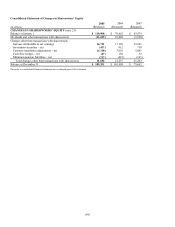GE 2005 Annual Report Download - page 59
Download and view the complete annual report
Please find page 59 of the 2005 GE annual report below. You can navigate through the pages in the report by either clicking on the pages listed below, or by using the keyword search tool below to find specific information within the annual report.(59)
REVENUE RECOGNITION ON LONG-TERM AGREEMENTS to provide product services (product services
agreements) requires estimates of profits over the multiple-year terms of such agreements, considering factors such
as the frequency and extent of future monitoring, maintenance and overhaul events; the amount of personnel, spare
parts and other resources required to perform the services; and future billing rate and cost changes. We routinely
review estimates under product services agreements and regularly revise them to adjust for changes in outlook. We
also regularly assess customer credit risk inherent in the carrying amounts of receivables and contract costs and
estimated earnings, including the risk that contractual penalties may not be sufficient to offset our accumulated
investment in the event of customer termination. We gain insight into future utilization and cost trends, as well as
credit risk, through our knowledge of the installed base of equipment and the close interaction with our customers
that comes with supplying critical services and parts over extended periods. Revisions that affect a product services
agreement’ s total estimated profitability will also result in an immediate adjustment of earnings. We provide for
probable losses.
Carrying amounts for product services agreements in progress at December 31, 2005 and 2004, were $4.4 billion
and $3.7 billion, respectively, and are included in the line, “Contract costs and estimated earnings” in note 17.
Adjustments to earnings resulting from revisions to estimates on product services agreements have been
insignificant for each of the years in the three-year period ended December 31, 2005.
Further information is provided in note 1.
ASSET IMPAIRMENT assessment involves various estimates and assumptions as follows:
INVESTMENTS. We regularly review investment securities for impairment based on both quantitative and
qualitative criteria that include the extent to which cost exceeds market value, the duration of that market decline,
our intent and ability to hold to maturity or until forecasted recovery and the financial health of and specific
prospects for the issuer. We perform comprehensive market research and analysis and monitor market conditions to
identify potential impairments. Further information about actual and potential impairment losses is provided in the
Financial Resources and Liquidity-Investment Securities section and in notes 1 and 10.
LONG-LIVED ASSETS. We review long-lived assets for impairment whenever events or changes in
circumstances indicate that the related carrying amounts may not be recoverable. Determining whether an
impairment has occurred typically requires various estimates and assumptions, including determining which
undiscounted cash flows are directly related to the potentially impaired asset, the useful life over which cash flows
will occur, their amount, and the asset’ s residual value, if any. In turn, measurement of an impairment loss requires a
determination of fair value, which is based on the best information available. We derive the required undiscounted
cash flow estimates from our historical experience and our internal business plans. To determine fair value, we use
our internal cash flow estimates discounted at an appropriate interest rate, quoted market prices when available and
independent appraisals, as appropriate.
























